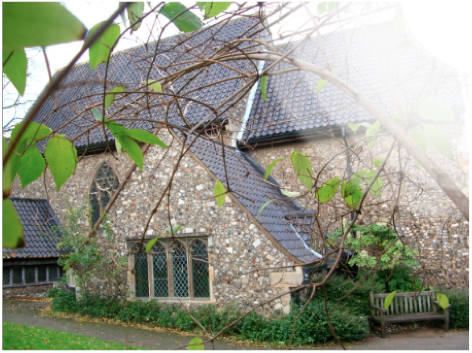

Julian of Norwich was a medieval British anchoress born sometime around 1343. She lived to her 70s before dying sometime after 1416. Much of that time was spent in a four-walled cell attached to a St. Julian's Church in Norwich.

It is difficult to say if Julian was her real name, who her family was, and what happened in her early life. It's speculated that she may have been a mother before her life as an anchoress. There is more speculation that she lost family members, got sick, and was perhaps put under quarantine during the Bubonic Plauge, which would have occurred when she was a young girl.

To become an anchoress, Julian would have had to undergone a rigorous selection process. Afterwards, a ceremony was likely been held in the church. Psalms from the Office of the Dead (typically sung during funerals) would have been recited as she was led into her cell. In the same ceremony, the door would have been seeled behind her.

Norwich was a pretty well-populated and active part of Britain. Julian's cell also probably had a window. She wouldn't have completely isolated from the rest of the world. People probably came to her window frequently and asked for her advise as a spiritual advisor. She couldn't leave her cell, but people could come to her, and many probably did.


Photo of Julian's cell's interior

Sometime in her 30s (possibly before she was an anchorite), Julian became gravely ill, and she found herself on her deathbed. During this time, she experienced visions (what she called shewings) of Jesus Christ. After she recovered from her illness, she would later write her experiences down in the form of "Revelations of Divine Love."

Revelations of Divine Love have two main versions. There's the Short Text, which was the version she wrote soon after her recovery. The Long Text is 86 chapters and roughly 63,500 words (six times longer than the Short Text). It seems to have gone through numerous revisions, with the final revision written soon before her death in the 1410s and 20s.

The Short Text isn't the original manuscript, but a surviving copy. It begins with: ""Here es a vision schewed be the goodenes of god to a devoute woman and hir name es Julyan that is recluse atte Norwyche and zitt ys on lyfe anno domini millesimo ccccxiii" This information, specifically Julian's name and gender, were left out of the Long Text. This copy was lost for 150 years before being rediscovered by the British Museum in 1910.

Revelations of Divine Love is especially famous as one of the oldest medieval texts written by a woman and one of the only surviving texts written by an anchorite.

Because of the English Reformation, which would have considered the text heretical, the Long Text was published and distributed in England a little less than three centuries after Julian's death. The Long Text was published in 1670 by a Benedictine monk named Serenus de Cressy. A manuscript preserved by the British Museum was eventually transcribed and published in 1910. Before the 20th century, very little was written about Julian or her writing at all.

There is an order of Episcopal nuns known as the Order of St. Julian of Norwich. The order was formed in Connecticut in 1985, but its base of operations is located in Wisconsin. The nuns frequently engage in community works, but practice "detachment, simplicity, [and] silence." In the "About Us" section of their website, they write: "To live the contemplative life is to occupy the prophetic hidden ground that offers space for God to work, in the way God chooses. Julian embodied this difficult work by holding in tension the seemingly irreconcilable aspects of human frailty and human goodness, making space in herself for the trust and vulnerability necessary to keep the heart open to God’s presence and mercy."


Photo of a nun of St. Julian of Norwich


Photo of Julian's cell's exterior

In Revelations of Divine Love, Jesus Christ is called a brother, but he is also compared to a "perfect mother" and is metaphorically tied to concepts such as conceiving, birth, weaning, and childcare. God is described with both masculine and femenine qualities, and is referred to as both a mother and a father.

Julian wrote the entirety of the Long Text in her cell, and probably didn't share her writing with the church or with many people who came to visit her. They were only discovered after her death.

Julian wrote entirely in medieval English. She didn't write in Latin, the lingua franca of the time, likely because women were typically barred from learning it.

As I've mentioned before, the Long Text wasn't published and distributed in England until 1670. However, many individual copies of the text were written by exhiled nuns throughout the 16th century, specifically in the French town of Cambrai. Serenus de Cressy was a confessor of these Cambrai nuns, which was how he acquired a manuscript of the Long Text.

Throughout the text there are several striking images. While sick in bed, Julian sees "red blood trickling down from under the Crown of Thorns" on a crucifix in her room. She sees Mary as a young girl. Jesus appears before her and offers her something "the size of a hazelnut," which is equivilated with his love. He takes her to the bottom of the ocean. At some point, Jesus suddenly gets covered in blood, which flows "through Hell, Heaven, and Earth." He stares into his own wounds (the stigmata). Afterwards, Jesus' body rapidly dries and decays, and Julian sees an unrelated, unnamed, "ugly" corpse, which expels the soul of a "beautiful child." In the final chapters of Divine Love, the devil makes an appearance and causes Julian to feel an almost unbearable amount of pain before he is banished by Christ's death on the cross.

The text is titled "Revelations of Divine Love because it is about the nature of God's love. God is a primary character in Divine Love, and is largely characterized as a figure of overwhelming love. Jesus is defined as the "living" representation of this love. In the first few chapters, Julian discusses whether or not God is good or evil, a heredical question in many circles. Julian ultimately decides that God is good, but it takes a certain amount of atonement (along with the shedding of shame and inhibition) to fully understand this love. God is Love. This is the ultimate paradox of human consciousness, and we can only transcend it through meditation and a deeper understanding of suffering.

In Chapter 22, Jesus, described as Julian's divine mother, tells Julian directly that his suffering is his joy. "It is a joy, a delight and an endless happiness to me that I ever endured suffering for you, and if I could suffer more, I would suffer more." Later she writes, "We are his joy, we are his reward, we are his glory, we are his crown [of thorns]."

Text from a study guide analysis of Divine Love: "She likens the goal of understanding the difficult paradoxical nature of God's love with the problem of evil on the earth to the also difficult paradox of gender and the creation of life in a mother's womb. She arrives at a perfect androgyny, saying that Jesus Christ is her own mother."

The stages of Jesus' death and decay are described in-depth in Divine Love. In Chapter 23, Julian reviews the five stages.The first four are "bleeding of the head, discoloring of the face, bleeding of the body from the scourging, and death." The fifth is the "joy and delight of the Passion."

In Chapter 64 (in which Julian sees the unnamed corpse), Julian posits that because we can't see God while we're alive, we're naturally inclined to want to die and go to heaven.

I have to be honest. I was not a huge fan of Revelations of Divine Love. It was long and sort of repetitive and I skimmed through a lot of it. The history behind it was more interesting to me than the text itself. I did find the tension between Divine Love's optimism and morbidness interesting, and it made me confront my own confusion with the two concepts. Her thoughts on gender and the Christian god completely threw me for a loop and were a pleasent surprise. I had no idea what to make of them expect, "Hell yeah."

 Visual of Divine's Love history of copying, publication, and translation.
Visual of Divine's Love history of copying, publication, and translation.































 Visual of Divine's Love history of copying, publication, and translation.
Visual of Divine's Love history of copying, publication, and translation. 
